Day of the Outlaw (1959)
Directed by: André De Toth
Written by: Lee E. Wells, Philip Yordan
Starring: Alan Marshal, Burl Ives, Robert Ryan, Tina Louise
USA
AVAILABLE ON DUAL FORMAT BLU-RAY AND DVD: NOW, from EUREKA ENTERTAINMENT
RUNNING TIME: 92 min
REVIEWED BY: Dr Lenera, Official HCF Critic
Ruthless cattleman Blaise Starrett rides into the small, snowbound town of Bitters with his foreman Dan to settle a feud with homesteader Hal Crane over access to land, using the pretext of the barbed wire he is running around his farm. However, what he’s really after is Crane’s wife Helen, with whom he once had a love affair before she got married. Helen turns him down, but tensions continue to rise until a showdown in the saloon which is then rudely interrupted by the arrival of outlaw Captain Jack Bruhn, an ex-Cavalry officer who, along with his unruly men, has just robbed a bank. They only need to stay the night, but they take over the town. Bruhn forbids his men to drink and touch the town’s women, but for how long?….
Though I consider myself relatively ‘well up’ on old movies, prior to watching Day Of The Outlaw, a film I knew nothing about but which I was keen to watch as some kind of lead-up to The Hateful Eight which is also a Western set in the snow [and which seems like it may have taken some inspiration from this film], the name Andre De Toth had been known to me solely as the director of the early 3D horror film House Of Wax. However, after watching this very stark, bleak Western which avoids many of the typical Western tropes and in some ways comes across more as a film noir, I’m certainly interested in checking out more of his work. Day Of The Outlaw was, to me, one of those films that started off okay – decent, but nothing special – but just got better and better as it went on until it got really good indeed, finally climaxing in a truly terrific final reel where the film had some genuine allegorical power and was truly evocative and mysterious. It provides more evidence that, while the likes of Sergio Leone and Sam Peckinpah get lots of credit for reinventing the genre, filmmakers like De Toth, Anthony Mann, Nicholas Ray, Samuel Fuller, Robert Aldrich and Budd Boetticher were doing it much earlier, but don’t seem to have received much credit for doing so. To 1959 viewers, Day Of The Outlaw much have seemed quite startling.
It was based on a 1955 novel of the same title by Lee Edwin Wells, that also ran in several newspapers as a serialised story in 1955 and 1956. Producer Buddy Adler originally purchased the film rights as a vehicle for Robert Wagner, though he turned it down. My interest in the film grew when I saw the name of Philip Yordan, writer of one of my favourite historical epics El Cid and another very ‘different’ western of the 1950’s, Johnny Guitar, on the opening credits. He wrote the script for the film though star Robert Ryan, who should be credited with helping to get it made, also had a hand. Filmed independently on a very small budget in central Oregon at Dutchman Flat and Todd Lake Meadows near the town of Bend in late November and early December 1958, with Leon Chooluck the unit director doing many of the long exterior shots, it was a tough shoot, though the crew’s demands for ‘danger money’ stopped when De Toth went and stripped down in the snow! However, Ryan was out for a week with pneumonia, snowstorms caused delays in filming, De Toth decided to shoot some scenes which were intended to take place inside to outdoors, and they then ran out of money and had to finish the film in the studio. Yordan was disappointed with the film, which made no impact at the box office, but its cult reputation grew considerably afterwards.
The opening credits occur over typical shots of two men on horses approaching a town, but the mood is already very different to your usual Western because of the dramatic, menacing music [by Alexander Courage, writer of countless memorable TV themes, most notably Star Trek, no less] that plays over them. The absence of your usual ballad or lyrical theme immediately lets you know that this film is not going to be another nostalgic, positive look at the Old West. Our supposed ‘hero’ hardly seems to be a heroic sort. He’s a cowboy that wants to graze his herd on land being fenced off by local farmers, but clearly one who is used to getting what he wants be fair means or foul and has probably killed many people who stood in his way. Like Shane, his past is merely hinted at here and there. It’s perhaps not surprising that his ex-girlfriend, now married to his main opponent, turns him down when he tries to rekindle their affair, though a few scenes later she offers herself to him [surprisingly blatantly for the time, but, as we will see, it’s quite a blatantly sexual film throughout] so he won’t kill her husband. I’m going to admit that I found some of these early scenes a little awkward and even confusing – I think I missed a couple of bits of information – and this wasn’t helped by the dialogue not always being that clear. Nevertheless it all seems to be building to a showdown, and Starrett [it can’t be an accident that he shares his surname with the main family in Shane] faces off with Crane and two others, Crane getting his foreman to roll a bottle along the bar until it will fall off and Starrett will shoot [he’s obviously done this loads of times before] as the camera tracks it, but the door is suddenly burst open, stopping the bottle’s progress.
Here is where the film begins to take off somewhat, and carries on getting better. The suspense just continues to increase as the outlaws take over the town, providing in particular some very uncomfortable sexual tension as all the villains except for Crane are after the local women and Crane tries to hold them back, this climaxing in a tremendously shot, with lots of dizzying circular pans, dance sequence, a grotesque parody of your typical Western dance scene which usually reinforces community and civilisation, where Crane lets his men dance with the women, a scene which becomes surprisingly cruel and I’m not sure really belongs in a ‘PG’ rated film. The movie constantly blurs the line between good and evil though, and even gets us to want Crane to survive when the local veterinarian has to operate on him, while one of his men seems to be rather nice and forms a bond with one of the women in a very sweet, understated example of a possible love that could have flourished in another time and another place, though this guy still warns the others that Starrett could be lying to them. Starrett himself does assume the role of hero, and he does decide to try and save the day, but there’s no typical Western-style eulogising of the gunfighter here, the key scene perhaps being a moment when he says that he’s no better than the bad guys, who at least don’t pretend to be anything that they’re not.
Though there is quite a memorable brawl, Day Of The Outlaw mostly avoids gunplay, and when the action switches to outdoors in the film’s tremendous final half hour, it’s the elements that present the real danger, and which soon have the upper hand. Russell Harlan’s superb cinematography really comes into its own while it’s obvious that there’s no resorting to a set until the final couple of scenes, though animal lovers won’t enjoy the sight of horses having a really rough time of as they’re beaten and driven through the snow. In any case, the film gets genuinely poetic when it reaches its downbeat climax which gives us some rather haunting images, though the final scene doesn’t really go with what came before, as if a major studio had demanded a reshoot, though that wasn’t actually the case, and one is still left wanting some answers, which is probably appropriate anyway. When the film came to its conclusion, I was more thinking about how imaginatively De Toth and Harlan had shot much of it, such as an early dialogue scene between Starrett and Helen played out largely with part of Starrett’s face looming out from the side of the screen, and also how darn convincing the settings were [well, they were mostly real!], with, for example, hardly any goods on the shop shelves and very few bottles of booze behind the bar.
I’ve always loved Ryan, with that tough, lived-in face and his very realistic acting, and he’s typically good here, even though you can tell he’s ill some of the time [which actually adds to the realism]. Tina Louise lets the side down somewhat – she’s just not up to the part though she’s hardly playing the best written character anyway – but Burl Ives, despite not looking especially menacing, makes Bruhn’s ability to impose his will on this gang believable, and his gang are a well drawn, if often deeply unpleasant – there are times with this lot when the film almost threatens to turn into Last House On The Left. Despite its title which doesn’t really evoke it at all, and a mediocre opening reel, Day Of The Outlaw turns into a rather good melding of film noir and the Western and is in some ways quite remarkable. It’s also quite modern in feel and doesn’t really feel dated at all. And I’m not sure I’ve ever seen a movie with so much snow. It was something of a surprise for me and I’d certainly recommend it. Right….let’s see what else De Toth has made….
Eureka Entertainment’s Blu-ray of Day Of The Outlaw maintains the film’s ‘rough and ready’ low budget look while providing considerable depth and contrast and doing a good job with the often unusual camera setups and oddly filled frames. Some of the dialogue in the first fifteen or so minutes is, as I mentioned earlier, a bit hard to make out, but things quickly improve. Though there isn’t much in the way of special features, director Bertrand Tavernier, who was friends with De Toth, offers an excellent appreciation of the film which is well worth listening to.
SPECIAL FEATURES
*High-definition 1080p presentation of the film on the Blu-ray
*Video appreciation by filmmaker Bertrand Tavernier
*Optional English subtitles for the deaf and hard-of-hearing
*Isolated music and effects track
*Double-sided sleeve featuring alternate artwork
*32-PAGE BOOKLET featuring a new essay by critic Glenn Kenny, a 1994 interview with De Toth, the films original press book, illustrated with archival imagery

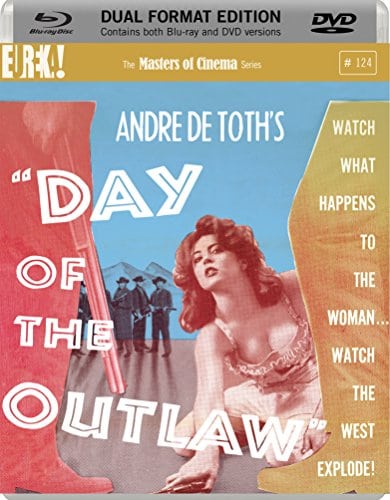
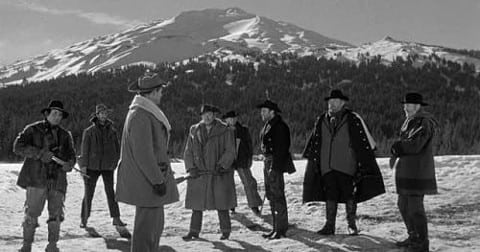
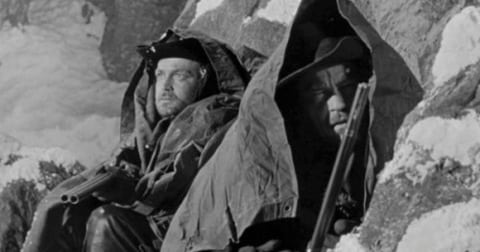




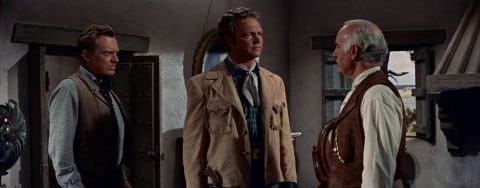

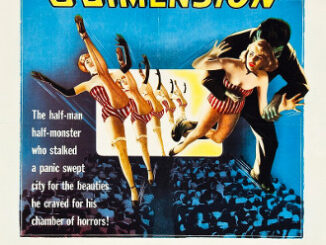
Be the first to comment